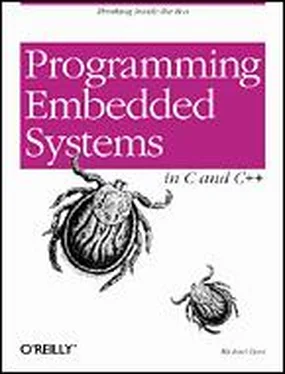This is in direct contrast to the personal computer in the family room. It too is comprised of computer hardware and software and mechanical components (disk drives, for example). However, a personal computer is not designed to perform a specific function. Rather, it is able to do many different things. Many people use the term general-purpose computer to make this distinction clear. As shipped, a general-purpose computer is a blank slate; the manufacturer does not know what the customer will do with it. One customer may use it for a network file server, another may use it exclusively for playing games, and a third may use it to write the next great American novel.
Frequently, an embedded system is a component within some larger system. For example, modern cars and trucks contain many embedded systems. One embedded system controls the anti-lock brakes, another monitors and controls the vehicle's emissions, and a third displays information on the dashboard. In some cases, these embedded systems are connected by some sort of a communications network, but that is certainly not a requirement.
At the possible risk of confusing you, it is important to point out that a general-purpose computer is itself made up of numerous embedded systems. For example, my computer consists of a keyboard, mouse, video card, modem, hard drive, floppy drive, and sound card — each of which is an embedded system. Each of these devices contains a processor and software and is designed to perform a specific function. For example, the modem is designed to send and receive digital data over an analog telephone line. That's it. And all of the other devices can be summarized in a single sentence as well.
If an embedded system is designed well, the existence of the processor and software could be completely unnoticed by a user of the device. Such is the case for a microwave oven, VCR, or alarm clock. In some cases, it would even be possible to build an equivalent device that does not contain the processor and software. This could be done by replacing the combination with a custom integrated circuit that performs the same functions in hardware. However, a lot of flexibility is lost when a design is hard-coded in this way. It is much easier, and cheaper, to change a few lines of software than to redesign a piece of custom hardware.
Given the definition of embedded systems earlier in this chapter, the first such systems could not possibly have appeared before 1971. That was the year Intel introduced the world's first microprocessor. This chip, the 4004, was designed for use in a line of business calculators produced by the Japanese company Busicom. In 1969, Busicom asked Intel to design a set of custom integrated circuits-one for each of their new calculator models. The 4004 was Intel's response. Rather than design custom hardware for each calculator, Intel proposed a general-purpose circuit that could be used throughout the entire line of calculators. This general-purpose processor was designed to read and execute a set of instructions — software — stored in an external memory chip. Intel's idea was that the software would give each calculator its unique set of features.
The microprocessor was an overnight success, and its use increased steadily over the next decade. Early embedded applications included unmanned space probes, computerized traffic lights, and aircraft flight control systems. In the 1980s, embedded systems quietly rode the waves of the microcomputer age and brought microprocessors into every part of our personal and professional lives. Many of the electronic devices in our kitchens (bread machines, food processors, and microwave ovens), living rooms (televisions, stereos, and remote controls), and workplaces (fax machines, pagers, laser printers, cash registers, and credit card readers) are embedded systems.
It seems inevitable that the number of embedded systems will continue to increase rapidly. Already there are promising new embedded devices that have enormous market potential: light switches and thermostats that can be controlled by a central computer, intelligent air-bag systems that don't inflate when children or small adults are present, palm-sized electronic organizers and personal digital assistants (PDAs), digital cameras, and dashboard navigation systems. Clearly, individuals who possess the skills and desire to design the next generation of embedded systems will be in demand for quite some time.
One subclass of embedded systems is worthy of an introduction at this point. As commonly defined, a real-time system is a computer system that has timing constraints. In other words, a real-time system is partly specified in terms of its ability to make certain calculations or decisions in a timely manner. These important calculations are said to have deadlines for completion. And, for all practical purposes, a missed deadline is just as bad as a wrong answer.
The issue of what happens if a deadline is missed is a crucial one. For example, if the real-time system is part of an airplane's flight control system, it is possible for the lives of the passengers and crew to be endangered by a single missed deadline. However, if instead the system is involved in satellite communication, the damage could be limited to a single corrupt data packet. The more severe the consequences, the more likely it will be said that the deadline is "hard" and, thus, the system a hard real-time system. Real-time systems at the other end of this continuum are said to have "soft" deadlines.
All of the topics and examples presented in this book are applicable to the designers of real-time systems. However, the designer of a real-time system must be more diligent in his work. He must guarantee reliable operation of the software and hardware under all possible conditions. And, to the degree that human lives depend upon the system's proper execution, this guarantee must be backed by engineering calculations and descriptive paperwork.
1.2 Variations on the Theme
Unlike software designed for general-purpose computers, embedded software cannot usually be run on other embedded systems without significant modification. This is mainly because of the incredible variety in the underlying hardware. The hardware in each embedded system is tailored specifically to the application, in order to keep system costs low. As a result, unnecessary circuitry is eliminated and hardware resources are shared wherever possible. In this section you will learn what hardware features are common across all embedded systems and why there is so much variation with respect to just about everything else.
By definition all embedded systems contain a processor and software, but what other features do they have in common? Certainly, in order to have software, there must be a place to store the executable code and temporary storage for runtime data manipulation. These take the form of ROM and RAM, respectively; any embedded system will have some of each. If only a small amount of memory is required, it might be contained within the same chip as the processor. Otherwise, one or both types of memory will reside in external memory chips.
all embedded systems also contain some type of inputs and outputs. For example, in a microwave oven the inputs are the buttons on the front panel and a temperature probe, and the outputs are the human-readable display and the microwave radiation. It is almost always the case that the outputs of the embedded system are a function of its inputs and several other factors (elapsed time, current temperature, etc.). The inputs to the system usually take the form of sensors and probes, communication signals, or control knobs and buttons. The outputs are typically displays, communication signals, or changes to the physical world. See Figure 1-1 for a general example of an embedded system.
Читать дальше












